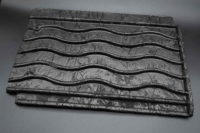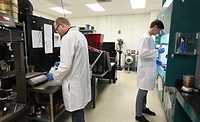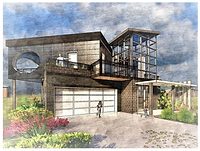X-MAT Receives $2.2 Million to Develop Coal-Based Building Materials

A conceptual drawing of X-MAT's home built from coal-derived materials. Images courtesy of X-MAT.
BLUEFIELD, W.V. — With its foundational pieces already in place, the Department of Energy has awarded X-MAT® an additional $2.2 million to continue its work building a house completely of coal. Over the past year, X-MAT has developed bricks, blocks, facades, panels, and roof tiles that comprise all the components needed to build a building.
With the DOE’s support and additional funding, the company will continue the process of creating a building made entirely from coal-based materials – from the structural columns to walls to roof tiles.
These coal-derived building materials are fire resistant, non-toxic, lightweight and durable, making them not only safer than their traditional counterparts, but easier to use and eco-friendly.
“This is coal reimagined,” said Bill Easter, founder of X-MAT®. “We’re honored to receive this funding from the DOE to continue the revolutionary work of repurposing coal and coal waste to bring these innovative, green building products to the marketplace.”
X-MAT CCC, the coal-derived building materials leader with a manufacturing pilot line in Bluefield, W.V., will continue to build a prototype structure to test their coal-derived building materials including roof tiles, siding panels, bricks, and blocks.
The company hopes to have a partial coal house constructed by 2023.
In total, the NETL has awarded X-MAT® and their partner, Semplastics over $10 million in grants and contracts. In addition to this most recent contract, the team received a $1.4 million contract to create new uses for coal waste, a $1.5 million grant for X-TILES™ and a nearly $1 million contract to help fund the research for turning coal into battery materials.
In addition to building materials the company’s battery division, X-BATT®, has combined coal with its proprietary, low-cost, resin-based technology to create full-cell batteries. Early tests in full coin cells show that the company’s batteries, utilizing this coal composite anode material, have reached over 400 cycles. X-BATT® has also scaled-up this technology, with the help of the Battery Innovation Center, into single layer pouch cells that have surpassed 100 cycles and are continuing to perform well.
Looking for a reprint of this article?
From high-res PDFs to custom plaques, order your copy today!





